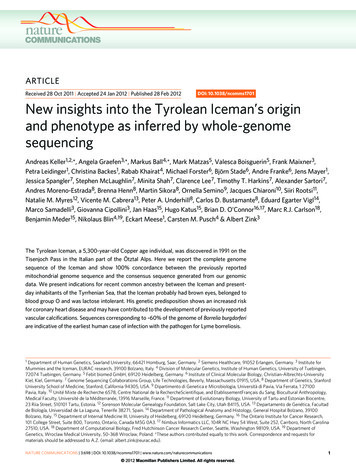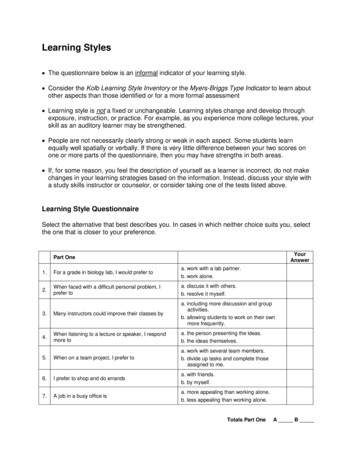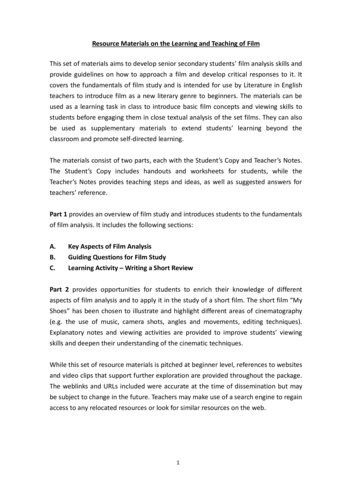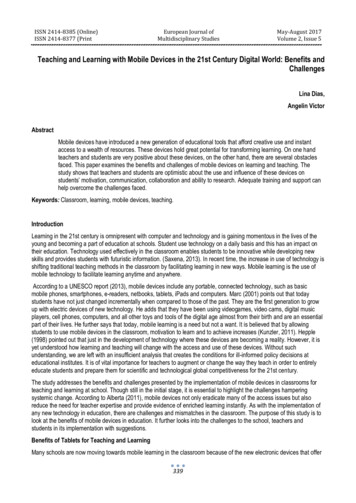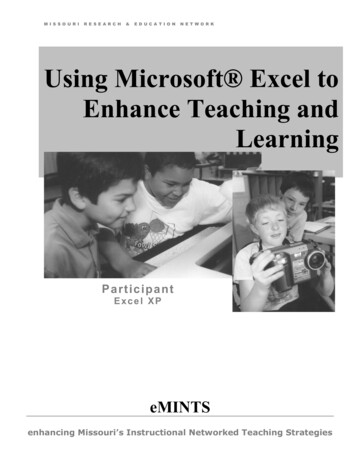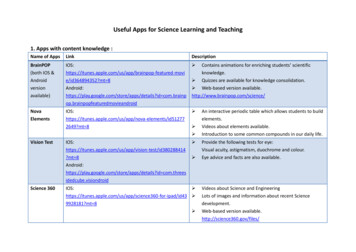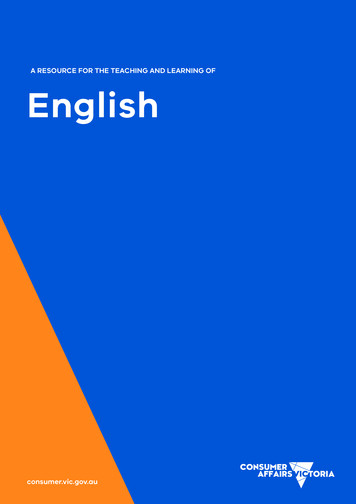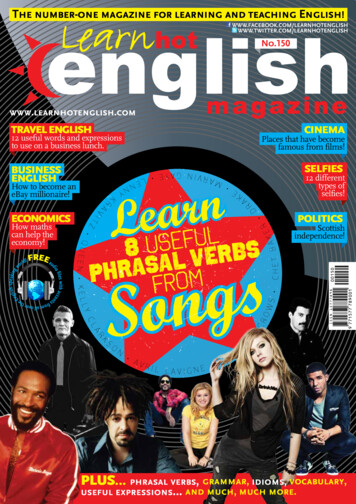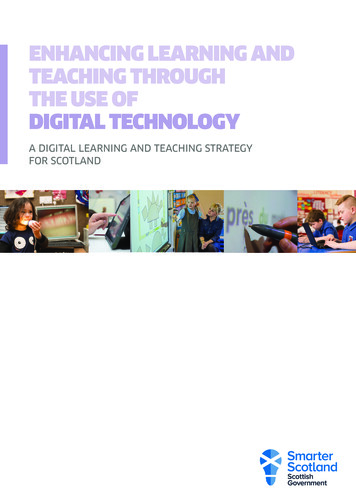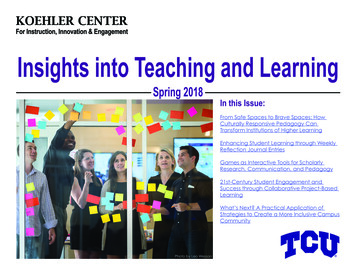
Transcription
Insights into Teaching and LearningSpring 2018In this Issue:From Safe Spaces to Brave Spaces: HowCulturally Responsive Pedagogy CanTransform Institutions of Higher LearningEnhancing Student Learning through WeeklyReflection Journal EntriesGames as Interactive Tools for ScholarlyResearch, Communication, and Pedagogy21st-Century Student Engagement andSuccess through Collaborative Project-BasedLearningWhat’s Next? A Practical Application ofStrategies to Create a More Inclusive CampusCommunityPhoto by Leo Wesson
From Safe Spaces toBrave Spaces: HowCulturally ResponsivePedagogy CanTransform Institutions ofHigher LearningLynn A. HamptonLecturer in John V. Roach Honors CollegeKoehler Center Diversity FellowDesmond MorrisDirector of Distance LearningThe 2018 Conference Theme isInstructional Methods, Innovation, andEngagementTopics Include: Cultural Awareness and InclusivenessInstructional MethodsDepartment Chair Development and SupportMeasuring Student LearningNew Faculty Support (Full-time and Adjunct)Learn more and register for this conference.Have you ever wondered why we tend to shy away fromconversations related to identity, oppression, power, andprivilege in the classroom? Have you ever wonderedwhy so many of us find it challenging to address racialmicroaggressions, intersectionality, and stereotype threatwithin academic spaces? Why is it that when we try toengage sensitive topics in the classroom around issues ofdiversity and inclusivity, we often become fraught with fearand defensiveness? Have you ever wondered how youcan become more effective in managing constructiveconflict within the classroom and enhance your capacityfor fostering a better climate of trust? Many scholars believethat infusing culturally responsive pedagogy into our dailyclassroom practices, not only has the capacity to enhanceinterpersonal communication and interaction amongour students, but it also has the potential to improve thequality of race relations on our nation’s college campuses(Ginsberg & Wlodkowski, 2009; Wing Sue, 2009).
What Is Culturally Responsive Teaching?Culturally responsive teaching is guided by a vision ofjustice and a pedagogy that seeks to transform as well asinform (Ginsberg & Wlodkowski, p. 24). One of the essentialcomponents of this pedagogical practice is that it allowsfor diverse populations within higher education to createmutually enhancing learning environments. According toGinsberg and Wlodkowski, “culturally responsive teachingoccurs when there is respect for the backgrounds andcircumstances of students regardless of individual statusand power, and when there is a design for learning thatembraces the range of needs, interests, and orientations ina classroom” (p. 24).This endeavor allows for more intentional and imaginativeinstructional practices (2009). One way to do this is totransition classroom dialogue from “safe spaces” to “bravespaces” (Arao and Clemens, 2013). For this context, “safespaces” are environments where students feel they areable to openly struggle with difficult dialogues concerningrace, cultural inclusion, and diversity. A “brave space,” onthe other hand, involves having courageous conversationsabout difficult topics. Having a courageous conversationmeans that all participants go through the painful processof seeking a new way to understand challenging issues(ie: racism, sexism, classism, etc.). The transition to creating“braves spaces” for faculty and students allows for a moregenuine commitment to enriching cultural awareness andsensitivity through the process of taking risks.What Does this Pedagogical Practice Look Likewithin the Classroom?Currently, Dr. Lynn Hampton is engaged in this pedagogicalapproach in her instruction of a newly designed TCU CREScourse titled, Engaging Difference & Diversity in America.In this course, students learn how to think critically andanalytically about culturally diverse issues in our society.Throughout the semester, students are guided on a journeyto help them frame dialogue around diversity and socialjustice. In doing so, they not only learn how to engage incourageous conversations about race and racism—theyalso learn how to interact authentically with one another bycreating a space for constructive confrontation and criticalinterrogation. Thus, helping them transition from a “safespace” to a “brave space.”Interested in Learning More? Attend the Workshop.Continuing the Conversation: ‘From Safe Spaces to Brave Spaces’The focus of this workshop is to learn how to more effectively integrate culturally responsive pedagogy into our daily classroompractices. Participants will develop strategies to enhance their awareness, sensitivities, knowledge, and understanding for how tobest foster learning experiences where students feel safe, respected, connected, and engaged.Wednesday, March 21, 2018, from 2:00 PM - 3:00 PMRees-Jones Hall, Rooms 113Register for this event.
Why Is Cultural Responsive Teaching Necessary atan Institution Like TCU?A consistent body of research documents that studentsfrequently consider race a taboo topic for discussion,especially in racially mixed settings—the importance of acourse like “Engaging Difference and Diversity in America”is that it fosters a learning environment that supportsstudents in the challenging work of authentic engagementwith regard to issues of identity, oppression, power, andprivilege. As a result of their participation in this type ofculturally responsive learning environment, students notonly grow in their understanding and awareness of thereality of racial inequality in our society, but they alsolearn how to engage with one another over controversialissues with honesty, sensitivity, and respect. The reasonthis instructional practice is so effective is because it hasbeen proven to enhance students’ capacity for improvedcultural competency. As an institution, TCU’s mission is “toeducate individuals to think and act as ethical leaders andresponsible citizens in the global community.” In short, ifwe truly want to equip our students to be global leaders,we need to coach them on how to confront one anotheracross differences. This means we must change our ideasabout how we (both teacher and student) learn; ratherthan fearing conflict, we have to find ways to use it as acatalyst for new ways of thinking and new opportunities forgrowth (bell hooks, 1994).Strategies for ImplementationRecently, Dr. Lynn Hampton and Desmond Morris, TCU’sDirector of Distance Learning, attended Cornell University’sTrain the Trainer Faculty Institute for Diversity in an effort tofind a viable framework for equipping instructors with thetools needed to effectively integrate culturally responsiveand inclusive teaching practices into the curriculum at TCU.As a result, the Koehler Center for Instruction, Innovation,and Engagement at TCU is developing a three-dayFaculty Institute for Diversity to be offered Summer 2018,modeled after Cornell University’s long-standing and highlysuccessful workshop. The Faculty Institute for Diversityprovides an opportunity for faculty to identify culturallybound assumptions and consider how they might influenceinteractions with students. Faculty will also examine coursecontent for diverse perspectives and apply specificdimensions of inclusive teaching models to their course.In turn, participating in this institute creates a network ofteacher-scholars who can promote best practices forincorporating diversity into the curriculum and addressingthe needs of diverse learners.ReferencesArao, B., & Clemens, K. (2013). From Safe Spaces to Brave Spaces. In L.Landerman (Ed.), The Art of Effective Facilitation (pp. 135–150). Sterling,VA: Stylus Publishing.“Faculty Institute for Diversity,” Center for Teaching Innovation, CornellUniversity.Gingsberg, M., & Wlodkowski, R. (2009). Diversity and Motivation:Culturally Responsive Teaching in College (Second Edition ed.). SanFrancisco, CA: John Wiley & Sons Inc.hooks, bell (1994). Teaching to Transgress: Education as the Practice ofFreedom. New York, NY: Routledge.Wing Sue, D. (2009). Racial Microaggressions and Difficult Dialogueson Race in the Classroom. Cultural Diversity and Ethnic MinorityPsychology, Vol. 15, No.2, 183-190.
Enhancing Student Learningthrough Weekly ReflectionJournal EntriesTee TylerAssistant Professor of Social WorkThis simple axiom guides my work as a Social Work educator:Students learn from experience. Lectures allow for thedissemination of information, classroom discussions allow forstudents to process information, but experiential learningopportunities allow students to develop a skillset that willtranscend beyond their time in my classroom and hopefullyafter they graduate from TCU.Experiential learning is a four-mode process:concrete experience, reflective observation, abstractconceptualization, and active experimentation (Kolb, 2015).For example, I provide a skill-training activity for my students,they reflect on what they learned, together we engage ina classroom discussion considering how what they learnedduring the activity applies to course content, and then theydevelop new goals to work on. These four modes continuein a cyclical manner.Enhancing student reflection is a challenging task. Providingactivities, leading classroom discussions, and supportinggoal development can occur within a larger classroomenvironment. Reflection is a process requiring studentsalone to determine how a classroom activity influencedthem. Enhancing individual student reflection is a goal I nowaccomplish through the ePortfolio tool in TCU Online.TCU Online ePortfolio Introduction:Showcase Yourself as a Teacher-ScholarIn this workshop, you will be introduced to the TCU OnlineePortfolio tool and how to collect artifacts of teaching andlearning. Individuals can use this tool as a solution for studentsto demonstrate growth and achievements or for facultyto build a tenure and promotion portfolio or presentation.Programs can use this tool as a solution to review artifacts ofstudent learning, view fulfilment of departmental learningoutcomes, and track progress toward discipline-specificcompetencies. At the end of this workshop, you will know howto setup reflections, upload and organize artifacts, createpresentations, and use the real-time mobile app to uploadartifacts or reflections.Tuesday, February 13, 2018, from 1:00 PM - 3:00 PMTCU Campus Store, Room 208Register for this event.ePortfolio Reflection JournalsStudents can use the ePortfolio tool in TCU Online as areflection journal. In only a few steps, students can write ashort 200–300 word reflection journal entry and share it withme online. In return, I can leave each student a customizedresponse regarding how their reflections uniquely relateto course content and future steps they can take tomaximize progress they are making in my class. Studentsare encouraged to address only in-class experiences intheir journal entries. This request narrows their focus tothe experiential learning activities in class. As a result, Ibecome aware of multiple internal perspectives regardingexperiences students shared together.
For example, consider students taking turns acting as clientsand social workers in a role-play activity. I can read theirreflection journals to assess what they are learning from theexperience of acting as a client. It is likely that sitting on“the other side of the table,” i.e., acting as a social workclient, provides new opportunities for students to experiencewhat it is like to receive social work services. After studentswrite in their journal entry about what it is like being a socialwork client, I can leave them comments regarding howtheir personal insights connect to their ongoing preparationfor professional practice. Using the ePortfolio allows me tomake individual comments on each student’s journal entry.Reflection journals illuminate diverse student perspectives.For example, after students participate in a classroomactivity focused on a particular social work topic, e.g.,substance abuse, it is likely each student will perceivethe activity differently. After reviewing student journalentries, I can return to class the following week and sharethemes common across all journal entries. I can also sharenoticeable differences in how students perceived parts ofthe activity. Journals remain confidential, yet, I can sharewith students any noticeable patterns of similarities ordifferences to enhance their learning.Looking for instructional ideas?Need help with TCU Online?Come to Open LabMondays, Tuesdays, Thursdays from 8:00 AM - 6:00 PMWednesdays from 1:00 PM - 6:00 PMFridays from 8:00 AM - 4:00 PMNo registration required.Koehler Center Lab: TCU Campus Store, Room 208Learn more on the Open Lab page.Interpersonal Classroom ModelI developed a teaching approach called the InterpersonalClassroom Model (ICM). The ICM incorporates ePortfolioreflection journals as a weekly assignment. Using this model,I teach students course content and provide experientiallearning activities. For example, when I teach grouppractice courses, I provide a short lecture on specific groupleadership skills and then students practice these skillsduring a weekly demonstration process group. Studentslearn to work together to build a cohesive interpersonalenvironment, a vital skill they will need to develop in order tosuccessfully lead groups for clients.The ICM teaching approach follows Kolb’s four-mode cycleexplicitly. For example, each week students participatein a demonstration group, write a reflection journal entry,apply their experiences to course content, and set newinterpersonal goals for the next demonstration groupmeeting. In this manner, the online reflection journal plays asignificant role in experiential learning theory application.Any instructor can incorporate reflection journals into theirpedagogy. Reflection journals provide instructors with afeasible way to hear from each student on a weekly basis.When students reflect on what they learn at the end ofeach week of class, it provides an opportunity for them toconnect classroom experiences with personal insights in ameaningful way. This may increase the likelihood studentswill remember what they learned in our class when our timetogether is over.ReferencesKolb, D. A. (2015). Experiential learning: Experience as the sourceof learning and development (2nd ed.). Upper Saddle River, NJ:Pearson.
Games as Interactive Tools forScholarly Research,Communication, andPedagogyNick BontragerAssistant Professor of New Media ArtWhat is a game? Does a game need to be “fun” tobe “successful”? Can games be studied as constructs,objects, or spaces of creative research? In this article, I willdiscuss these concepts while also addressing the notion ofplayers as agents of change/empowerment. By using thisframework to bridge the gap between creative and criticalexpression, we can begin to understand what a game maybe, and how a game can be used as a scholarly tool.The competitive and colonial nature of many games makethem ideal candidates for a type of humanities laboratory.Ongoing and emerging scholarly research can createa set of rules (protocol) for a player/agent to follow asthey attempt to reach a desired outcome. While a cardor board game may offer a chance to study social oranti-social action between players/agents, the infinitelycustomizable architecture and atmosphere of a videogame offers many unique points of study.Examples within fiction include Orson Scott Card’s 1985novel Ender’s Game in which a young boy is repeatedlyasked to defeat a race of aliens in a military simulationgame. His expertise in this game ultimately allows him tomake sacrificial decisions of “virtual” armies to achievethe final goal of defeating the aliens. He is then told thatA.C.E. Your Class!Active, Collaborative, and EngagedLearning Using Google DriveUse of Google Drive applications in your class can createopportunities for active learning, collaboration, andengagement. Whether you want students to interact withcontent, design and deliver group presentations, crowdsource information in a variety of formats, or provideconstructive feedback in real-time, the free, user-friendlyGoogle Drive apps provide students and instructors witha variety of learning options. Use of Google Drive canalso allow for more efficient and streamlined procedures,leaving you and your students more time to meaningfullyfocus on learning course content.In this workshop, you will learn the basics of how to use thecloud-based system in your class and practice engaging inreal-time collaboration. You will have access to a resourcebank of ideas and activities that are readily available foruse in your class. You will walk away having designed anew activity or transformed an existing assignment into acollaborative, student-centered activity using Google Driveapps. You can sign up for either or both workshops.Friday, April 13, 2018TCU Campus Store, Room 208Beginner Workshop from 1:00 PM - 2:00 PMIntermediate Workshop from 2:30 PM - 4:00 PMRegister for either or both of these workshops.
the battles were all in fact real, and he is then forced tounderstand he is complicit in the genocide of an alien race.This study of how a gaming environment affects complicitywithin systems can also be seen in Brenda Romero’s 2009board game Train. Players are concerned with the mostefficient loading of train cargo before a destination isreached; the player with the most efficient loading cargoto the unknown destination wins the game. Upon arrival,the destination is revealed to be a Nazi concentrationcamp and the cargo are prisoners.A number of recent video games have been describedas “walking simulators” in which a player can explore orbe witness to a created environment without conflict orrepercussions. Contrary to the aforementioned colonialor competitive aspect of gaming, this new environmentmay offer an invitation for the player to experience asoft fascination in which their mind can engage andwander freely. This disarming of our competitive or colonialexpectations also allows for the exploration of non-linearnarrative structures by the player. Different personalgoals, alignments, or family histories can be studied by agame creator as they see players from different social oreconomic backgrounds making unique choices in theirexplorations.How can metrics of social communication or successbe measured within or around an existing set of rules fora game? These issues are central to the conversationsurrounding our interaction and changes through theartifice of game versus player, player versus game, playerversus player, or even game versus game. There arenumerous facets to consider regarding communicationwithin game architecture; I will focus on the aspect ofvirtual versus real role-playing in gaming. The perceivedanonymity of the virtual role-playing experience (massivelymultiplayer online role-playing-games) can lead to extremecommunication behaviors by the players. These behaviorsTeaching and Learning ConversationsEnlivening the Humanities and Science Classroom Through the Moksha Gamewith Mark Dennis, Yushau Sodiq, Eric SimanekThis conversation will examine Moksha, a game that Mark Dennis, from TCU’s Religion Department, developed based on apan-Indian religious paradigm that includes the notion of karma, the law of cause and effect, and moksha, which means“liberation” or “freedom.” The game, which is played over the entire semester, rewards students for positive behavior, “goodkarma,” and penalizes them for disruptive behavior, “bad karma.” There is an individual and a team component to the game,which Mark Dennis has been using in his introductory World Religions course for the past six years. It has worked well as a tool forreducing distractions and promoting engagement. Two additional faculty who have started using the Moksha game will join theconversation: Yushau Sodiq from the Religion Department, who has used it in his World Religions course, a
and social workers in a role-play activity. I can read their reflection journals to assess what they are learning from the experience of acting as a client. It is likely that sitting on “the other side of the table,” i.e., acting as a social work clie
